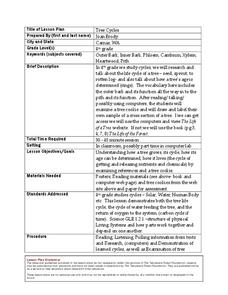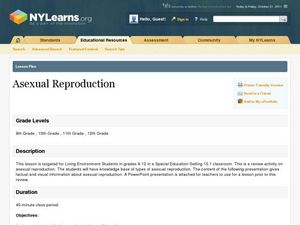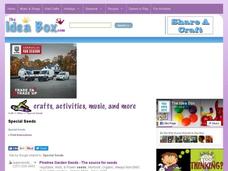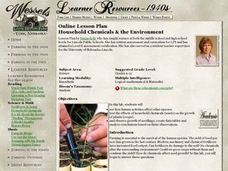Curated OER
Life in the Kelp Forest
Students research and create a marine food web to learn about plants and animals in a kelp forest. For this marine food web lesson, students draw lines between kelp forest predators and prey and show the flow of energy in the food web....
Curated OER
You Can Depend on Me
Students identify how they depend on others, and examine and discuss the images on the California Quarter Reverse. They view and discuss images of various habitats, complete a Habitat Research worksheet, and create a habitat diorama.
Curated OER
Are You Balanced With Your Environment?
Students discuss the impact of not keeping the environment in balance for future generations. As a class, they are introduced to the concept of "Balance of Nature" and what it means. In groups, they research the role of trees and how to...
Curated OER
Tree Cycles
Fourth graders investigate the life cycle of a tree by researching the Internet. In this plant life lesson, 4th graders observe The Life of a Tree website and discuss the life of a tree from sprout to death. Students create a cross...
Curated OER
Using the Scientific Method
Pupils practice using the scientific method. In this scientific processes instructional activity, students read and discuss the main parts of the scientific method. Pupils plan how they would conduct an experiment using the scientific...
Curated OER
Mystery Caterpillar Challenge and IPM or Organic Gardening Practices
In this caterpillar activity, students look at the picture of the caterpillar and identify what kind it is. Students then decide how to take care of it.
Curated OER
The Rainforest Community
Students create a miniature rainforest ecosystem, a terrarium. Students then explain how the continuous flow of energy and food in the ecosystem allows it to sustain itself.
Curated OER
A Book of Eighteenth Century Herbal Remedies
Learners discover the kinds of medicines used by midwives in the late 1700s by researching several herbs used by Martha Ballard. They research different herbs and found out how they have been used throughout history. Students create a...
Curated OER
Be Nice to Spiders Lesson Plan
Students share their own pages with the rest of the class while they learn about spiders. For this Be Nice to Spiders lesson plan, students learn how spiders are living creatures just like people.
Curated OER
Examining Seeds
Learners explore botany by conducting an investigation in class. In this seeds instructional activity, students utilize lima bean seeds and magnifying glasses to examine the different parts of a seed after it has been dissected. Learners...
Curated OER
Send Me A Postcard From The Rainforest
Students research the different regions of the rainforest by using the Internet. They create their own postcards from each region they examine showing the plants and animals of that region. They share their postcards with the class.
Curated OER
Asexual Reproduction
Sixth graders investigate how asexual reproduction produces single-parent offspring. They use plants and yeast to demonstrate vegetative propagation and budding in a laboratory. Students draw five different types of asexual reproduction.
Curated OER
Steps for Taking a Cutting for Your Own Forest at Home
Students study renewable and nonrenewable resources and take a hardwood cutting. In this hands on activity students learn what rooting hormones are, how they generate roots and then take their own cutting and root it.
Curated OER
What's Organic?
Young scholars define and discuss terms organic and synthetic, read article pertaining to organic agricultural practices in Oklahoma, complete worksheet, grow plants using both commercial and organic fertilizer, compare growth rates, and...
Curated OER
What are rice farmers doing to help the environment with their water-filled rice fields?
Third graders research rice fields. In this rice fields lesson, 3rd graders discuss how fields contribute to the environment by providing an important food source for birds. They find the benefits of rice fields to water and soil as well.
Curated OER
Special Seeds
Students create their own garden. In this gardening lesson, students get a packet of seeds and plant them in a special part of the garden. They are responsible for watering, weeding, and caring for their plants.
Curated OER
Air Pollution
Students identify the causes and effects of air pollution and how to reduce air pollution.
Curated OER
Flower Power
Students use video learning to explore how flowers make seeds and dissect their own flower, and make a flower with its reproductive parts out of construction paper.
Curated OER
Household Chemicals & the Environment
High schoolers conduct a laboratory experiment designed to investigate the effects of chemicals, soil quality and pollution on seed growth and plant yield. They consider how best to maximize agriculture in the long term.
Curated OER
Carrot Seed Lesson Plan
Learners create a seed museum. In this early childhood lesson plan, students identify various seeds and the plants the seeds will grow into. Learners write a description of the plant, illustrate the plant and create a seed museum in...
Curated OER
Planting Phil's Garden
Learners study how to care for plants. For this plant care lesson, students observe a plant care demonstration and examine flowers using their senses. They listen to Janet Wakefield's, What If Everybody Gave? They complete a community...
Curated OER
Shake, Rattle and Roll
Students compare the weathering of materials. in this weathering lesson, students experiment with the chemical and physical weathering of different materials. Students use salt and water as an example of how weathering occurs.
Curated OER
Why is rice important?
Second graders examine why rice is so important to the world. In this agriculture lesson, 2nd graders discover the origins of rice farming. Students study how many countries depend on rice for survival. Students research countries and...
Curated OER
Three Clouds Activity
Learners explore how clouds are produced through three different age-appropriate hands-on experiments.

























